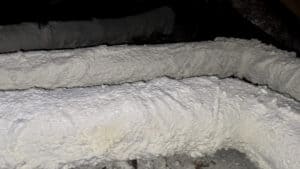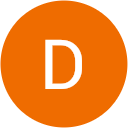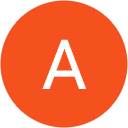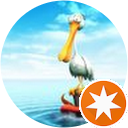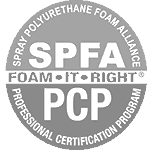Superior Ductwork Insulation in New Orleans: Why Keep Your Rigid Metal Ducts and Spray Foam Them
Homeowners in New Orleans face uniquely harsh climate challenges; extreme humidity, punishing attic heat, and a high water table. When upgrading insulation or HVAC, you deserve transparent, science-based guidance, not just what’s easiest for contractors. Below, you’ll find everything you need to know about why keeping your home’s original rigid metal ducts and upgrading them with closed-cell spray foam is the gold standard for lasting comfort, energy savings, and system longevity.
Take a look at these pictures of homes with rigid ductwork that were previously leaky, improperly sealed, and insulated with fiberglass wraps, and have now been professionally insulated with closed-cell spray polyurethane foam insulation by Diversified Energy.
Enjoy all of the benefits of having your HVAC ductwork air-sealed and insulated with spray polyurethane foam. Contact Diversified Energy to schedule a free consultation.
Why Not Replace Rigid Metal Ducts with Flex Duct?
Many HVAC contractors recommend removing original rigid metal ductwork in favor of flexible ducting. This is often done for speed and upfront cost savings. And, ultimately with intentions of a higher profit margin in mind. But it’s rarely in the homeowner’s best interest.
Key Reasons to Keep Your Rigid Metal Ductwork
Superior airflow & efficiency: Metal ducts provide a smooth, straight interior, allowing air to move freely with minimal resistance. Flexible ducts create turbulence and pressure drops, reducing overall system performance.
Unmatched durability: Rigid metal lasts for decades, resists sagging, tearing, and damage, whereas flexible ductwork is prone to kinks, crushing, and deterioration over time.
Cleaner air & easier maintenance: Metal duct interiors accumulate less dust and are less susceptible to mold or pest intrusion, helping maintain better indoor air quality.
Proper sizing & installation: Metal ducts are usually designed and installed to precise standards, while flexible duct runs often suffer from bends and excess length, further choking airflow.
Better long-term investment: While replacing with flex ducts might seem like a shortcut, it tends to raise energy bills, reduce comfort, and trigger more frequent repair needs down the line.
Bottom Line: If your metal ducts are structurally sound, they are rare assets. Instead of tearing them out, upgrade their insulation for even greater efficiency.Key Reasons to Keep Your Rigid Metal Ductwork
Get A Quote For Spray Foam On Your Ductwork
Why Not Replace Rigid Metal Ducts with Flex Duct?
Many HVAC contractors recommend removing original rigid metal ductwork in favor of flexible ducting. This is often done for speed and upfront cost savings. And, ultimately with intentions of a higher profit margin in mind. But it’s rarely in the homeowner’s best interest.
Key Reasons to Keep Your Rigid Metal Ductwork
Superior airflow & efficiency: Metal ducts provide a smooth, straight interior, allowing air to move freely with minimal resistance. Flexible ducts create turbulence and pressure drops, reducing overall system performance.
Unmatched durability: Rigid metal lasts for decades, resists sagging, tearing, and damage, whereas flexible ductwork is prone to kinks, crushing, and deterioration over time.
Cleaner air & easier maintenance: Metal duct interiors accumulate less dust and are less susceptible to mold or pest intrusion, helping maintain better indoor air quality.
Proper sizing & installation: Metal ducts are usually designed and installed to precise standards, while flexible duct runs often suffer from bends and excess length, further restricting airflow.
Better long-term investment: While replacing with flex ducts might seem like a shortcut, it tends to raise energy bills, reduce comfort, and trigger more frequent repair needs down the line.
Bottom Line: If your metal ducts are structurally sound, they are rare assets. Instead of tearing them out, upgrade their insulation for even greater efficiency.
Attic Ductwork: Why Spray Closed-Cell Foam, Not Fiberglass Wrap
Attics in New Orleans can exceed 140°F in summer with humidity over 80% year-round. Traditional fiberglass wrap can’t handle these punishing conditions.
Why fiberglass fails in local attics:
Loses up to 50% of R-value when exposed to moisture or temperature swings.
Breaks down from daily temperature swings (often 60–80°F variation).
Permits air infiltration, “thermal bridging,” and condensation, leading to mold and energy waste.
After storms/hurricanes, wet fiberglass must be replaced entirely, while foam can be cleaned and keeps working.
Why closed-cell foam excels:
Maintains R-value even when attic temps spike above 140°F.
Creates both an air seal and vapor barrier, preventing moisture and air leaks.
Lasts for decades, unaffected by pests, mold, or storm-related wetting.
Crawlspace Ductwork: Protecting Against the Gulf’s Extreme Moisture
Crawlspaces in New Orleans battle relentless humidity, high water tables, and salt air. Fiberglass duct wrap fails rapidly, sometimes in less than 2 years, while closed-cell foam provides permanent protection.
Why Spray Foam Insulation Is Essential in Crawlspaces
Total moisture resistance: Closed-cell foam’s dense, non-absorbent structure prevents water vapor infiltration, unlike fiberglass, which soaks up moisture and loses up to half its R-value.
Mold and rot protection: Foam blocks the condensation and sweating that spark rapid, destructive mold growth on ducts and framing, eventually to rusting ductwork after longer periods of time.
Salt air and flood resilience: Foam resists the corrosion and breakdown seen in coastal environments, and outlives repeated flooding events that destroy fiberglass insulation.
Energy & comfort: Maintains consistent duct temperature and prevents unconditioned crawlspace air from leaking into your home, reducing strain on your HVAC and saving on energy bills.
Extreme durability: Expected to last 80–100 years, closed-cell foam is a true “set it and forget it” solution for local homes.
Bottom line: For crawlspace duct insulation, closed-cell foam is not a luxury; it’s the only material proven to stand up to our climate.
Conclusion: The Diversified Energy Standard
Retaining your rigid metal ducts and upgrading to closed-cell spray foam insulation is the clear, science-backed solution for New Orleans’ unique climate. This approach preserves system airflow, keeps your ducts dry and mold-free, delivers real energy savings, and gives you peace of mind knowing you’ve invested in a solution that lasts.
When AC contractors suggest tearing out metal ducts for quick flex installs, ask them: “Why not save what’s better and make it even better?”
Rely on third-party studies and decades of building science expertise, not just sales pitches or what’s easiest for someone else.
Frequently Cited, Independent Sources
U.S. Department of Energy – Duct Sealing and Insulation
Oak Ridge National Laboratory – Attic and duct insulation performance
LSU AgCenter – Crawlspace moisture and insulation studies
GreenFiber, EnergyVanguard, ASHRAE Journal, [see the blog’s technical references for even more detailed third-party research]
Ready to upgrade your home for lasting comfort, energy savings, and real protection? Diversified Energy specializes in expert spray-foaming of your rigid ducts, attic or crawlspace, with solutions proven to outlast our climate’s toughest challenges.
Call To Schedule Your Appointment
Frequently Asked Questions
Insulating rigid/metal ductwork with closed-cell spray polyurethane foam insulation achieves two goals in a single application. First, it provides seamless insulation that will not sag or allow condensation to build up between the rigid ductwork and insulation. Second, it makes your ductwork airtight, eliminating air leakage and infiltration.
Yes! Leaky HVAC ductwork can increase your cooling and heating bill by up to thirty percent or more. Properly sealing and insulating your ductwork is one of the highest-payback energy efficiency improvements you can do. Plus, properly sealing your HVAC ductwork will significantly improve your indoor air quality.
Not when you consider all of the benefits of insulating your HVAC ductwork with spray polyurethane insulation. In one application of closed-cell spray polyurethane foam, your ductwork is air-sealed and insulated.
If you want to go the traditional route of insulating with fiberglass wraps, you first need to ensure that every seam and every connection is properly sealed with mastic and fiber tape so your ductwork is air-tight. Then, you need to wrap the ductwork with fiberglass and ensure that there aren’t any gaps or sags where condensation can build up.
Absolutely! When you insulate the ductwork under a raised house with closed-cell spray polyurethane foam insulation you get all the benefits of a single product application that air-seals and insulates, but you’re also not providing a potential nesting area in fiberglass wrap insulation for rodents and bugs.
Yes! Please take a look at our Tax Incentives page for more information about Louisiana state and federal tax incentives for energy efficiency upgrades to your home.
